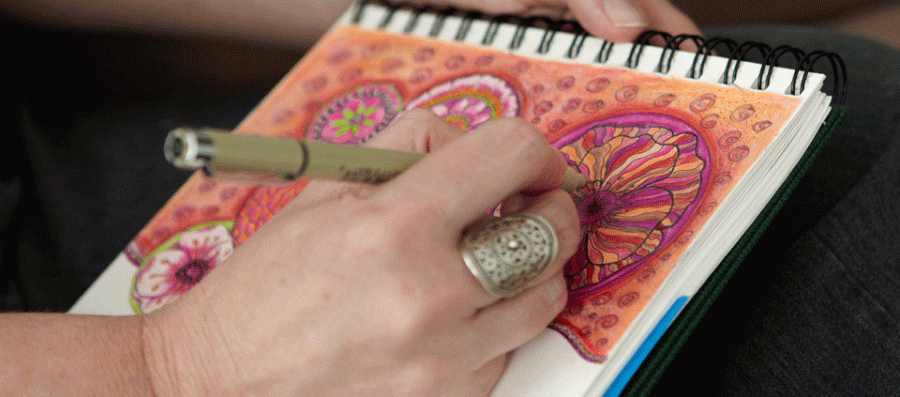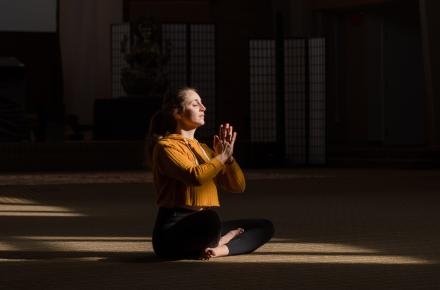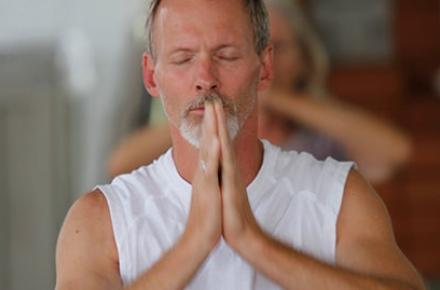How to Start a Mandala Practice, Plus a Free Coloring Book


Mandalas are everywhere. We see these circular designs with repeating patterns in coloring books, clothing, linens, and home decor. Mandala is a Sanskrit word that loosely translates as “circle” or “center.” While mandalas are rooted in Buddhist and Hindu traditions, humans have been fascinated by circular design motifs across all cultures and times. Celtic spirals, the Chinese yin/yang symbol, rose windows, and Navajo sand paintings are a few examples. In nature, we find mandala patterns in nautilus shells, pinecones, and the seed heads of sunflowers.
The practice of creating and coloring mandalas is more than making pretty pictures. Here are five reasons to start a mandala practice.
1. It relaxes the body and mind. A mandala practice can be as simple as coloring mandalas found in the many adult coloring books on the market today or downloaded for free from the web. Here's a Kripalu Mandala Coloring Book to get you started! When we unplug from our electronics in order to sit quietly and color, our bodies and minds relax. Focusing on filling the repeating shapes with color gives our minds a break from the worries of the day and the busyness in our schedules. As our minds relax, our bodies follow. For maximum benefit, turn off your phone and other devices, turn on some relaxing music, diffuse your favorite essential oils, and drink a warm beverage. Take it even further by practicing yoga, dancing, or soak in a warm bath before sitting down to color. The relaxation experienced from coloring mandalas eases stress and anxiety and helps you sleep.
2. It activates your creativity. Drawing your own mandala designs requires no artistic background. I tell my students, “If you can print your name and the alphabet, you can draw a mandala.” We use the same lines and shapes—vertical, horizontal, curved, diagonal—whether we draw the mandala freehand or within a grid. Within 15 minutes, I see students take flight in drawing their own mandala designs and discovering their creative abilities. Activating our creativity in this way helps us bring creativity to other areas of our lives.
3. It improves focus and enhances clarity. When you’re drawing a mandala, you can’t think about anything else. That clears the mind to be able to focus. After constructing the mandala, we shift gears to color it, and our attention may shift to our thoughts and feelings. We can quietly reflect on the day and use this time to brainstorm a solution to a problem, or consider possibilities for a decision that we need to make. One of my favorite practices is to focus on an intention, such as gratitude, while creating my mandala. I may even fill the shapes and spaces of my mandala with words and phrases to acknowledge what I appreciate in myself, others, and my life.
4. It centers and connects you. What’s the difference between coloring and drawing within a circle compared to other designs? The circle offers a safe container to focus one’s thoughts, feelings, and ideas—whether the mandala is in the traditional style, with the shapes radiating from the center, or a contemporary design that’s more freeform and abstract. As we draw a mandala and color it in, we see patterns emerge before us that may reflect the centeredness and connections found within ourselves, friends, family, colleagues, and communities, both local and global. These connections foster understanding and compassion toward ourselves and others.
5. It’s fun! Perhaps the number-one reason to start a mandala practice is the joy that comes from witnessing a work of art emerge from your own hands. A warning: Once you get started, you’ll find it hard to stop!





















































